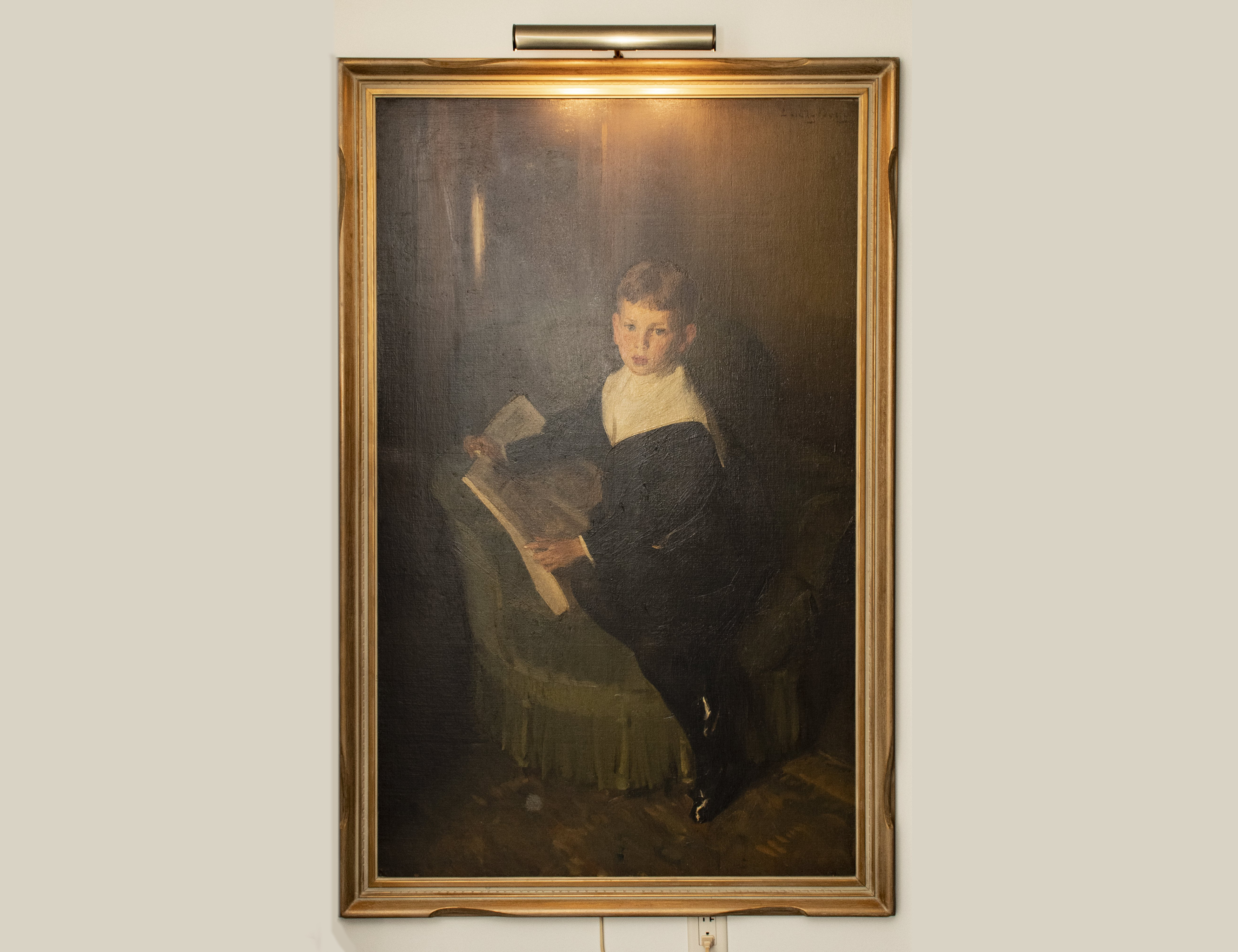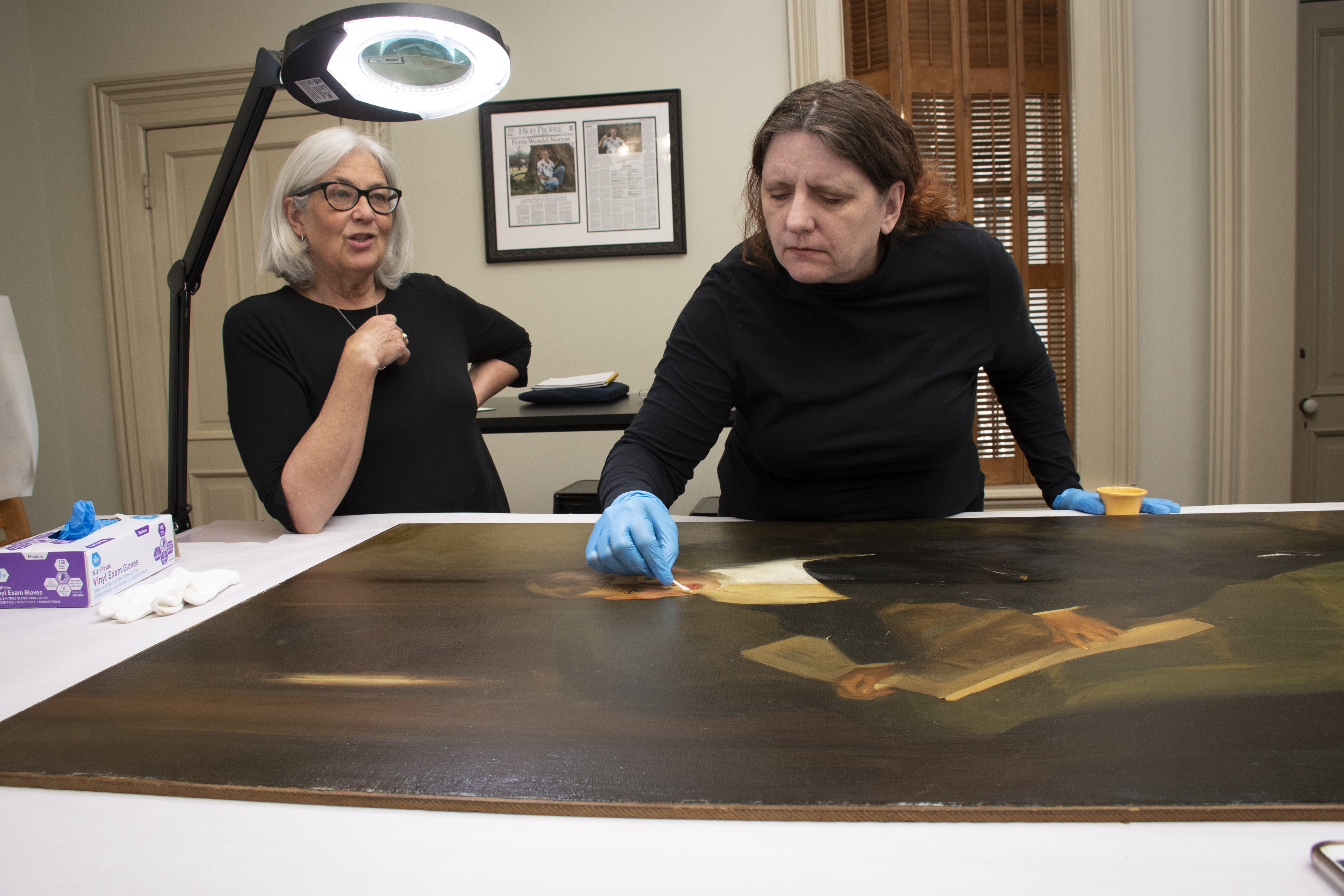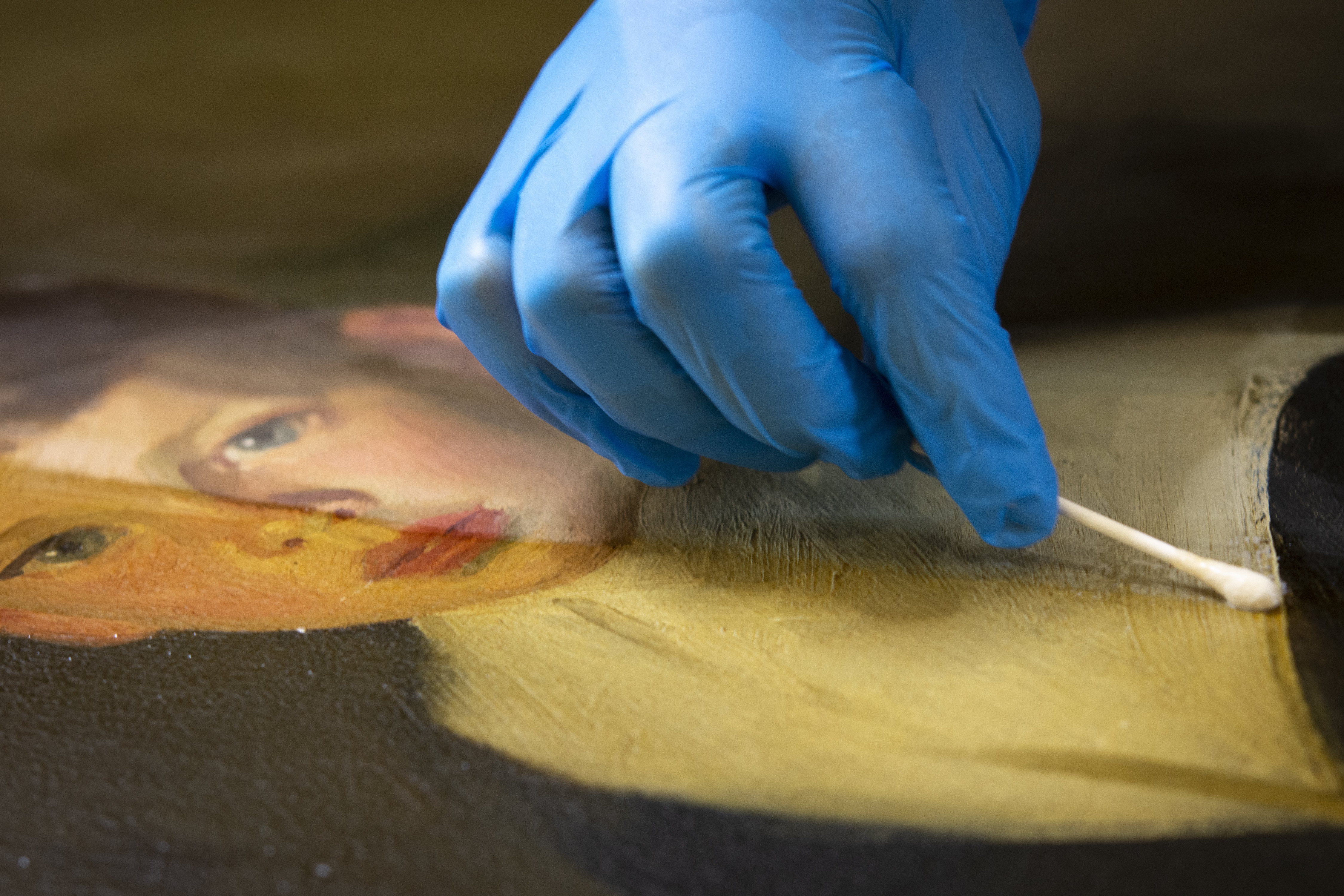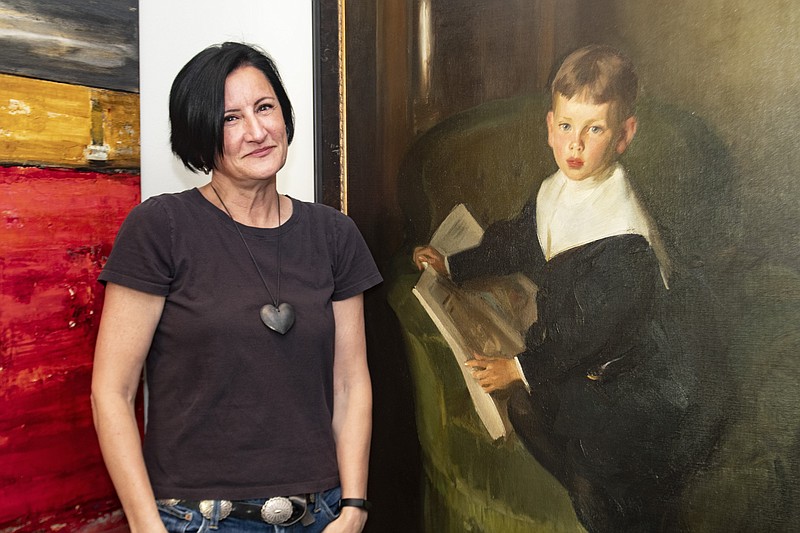Jennifer O'Brien's downtown Little Rock apartment is filled with art. There are paintings, pen and ink works and collages, many done by Arkansas artists like Donald Roller Wilson and Byron Werner.
A life-size oil painting of a young boy hangs at the end of a hallway. The child is William O'Brien Jr., a distant relative of Jennifer's. He sits in a green semicircular chair and looks directly at the viewer, as if we have just interrupted his reading of the open book next to him. There's no date on the work, which was painted by Louis Betts, but might be from around 1900.
The painting has inspired O'Brien, who is originally from the Chicago area, to learn more about her family's roots. There's also a Little Rock connection and now, after a meticulous restoration, little William looks much different from the way he looked just a few months ago.
■ ■ ■
It's Dec. 27 and O'Brien's Christmas tree stands in the living room of her bright, airy apartment. Adjacent to this space is her studio, where she creates vibrant, digital collages.
In 2009, O'Brien was working in health care administration when she moved to Little Rock to become chief executive officer of an orthopedic surgery practice. She hadn't planned to stay long — two or three years, tops — but she fell in love with Dr. Robert Lehmberg, a palliative care and hospice physician. They got married in 2012 and O'Brien settled in Little Rock with him, though they kept her Chicago condo.
In 2015 Lehmberg was diagnosed with stage four metastatic cancer and died in 2017. O'Brien chronicled this time through notes, collages and layered images in her award-winning 2020 book "The Hospice Doctor's Widow: A Journal," which was published by Little Rock-based Et Alia Press.
After Lehmberg's death, O'Brien decided to remain here and sold her place in Chicago. Much of the art on her walls was part of Lehmberg's collection, she says, and some are pieces they bought together. The portrait of young William, however, has been in the O'Brien family for generations.
She knew the painting was made by Betts, an accomplished portraitist, but didn't know that Betts was from Arkansas. It was during a conversation with Brian J. Lang, chief curator and Windgate Foundation curator of contemporary craft at the Arkansas Museum of Fine Arts, that she learned Betts was a Little Rock native.
"I told him I was bringing it from Chicago and he said 'You know, Louis Betts was from Little Rock.' He told me there were three paintings [by Betts] in the museum's collection. It was really exciting to know that the painting was coming to Betts' home."
Betts was born Oct. 5, 1873, in Little Rock. His father, Edwin, a landscape artist, was Louis' first teacher, according to the Encyclopedia of Arkansas. The portrait "Professor Armellini," one of the three in the Museum of Fine Arts' collection, was reportedly painted when Betts was just 16 in exchange for violin lessons.
The family did not stay in Little Rock long. Betts' mother died soon after his birth, and his father married one of her sisters. Betts' three siblings, who also became artists, where born in St. Louis, Chicago and New York, according to the encyclopedia.
Betts studied with William Merritt Chase, the influential American impressionist and teacher, at the Pennsylvania Academy of Fine Arts (Chase even painted an expressive portrait of the handsome young Betts), and also studied in Europe. He became a highly regarded artist whose portraits have been placed in the U.S. Capitol and are in the collections of Historic Arkansas Museum, the Smithsonian Institution, the Art Institute of Chicago, the Corcoran Gallery in Washington and others.
He was connected to the O'Brien family in Chicago, and this is where the portrait of William Jr. comes in.
 William O’Brien Jr. is depicted in this oil painting by Little Rock native Louis Betts. The work is undated, but is believed to have been done around 1900. This photo was taken in December, before the painting was cleaned by Norton Arts. (Arkansas Democrat-Gazette/Cary Jenkins)
William O’Brien Jr. is depicted in this oil painting by Little Rock native Louis Betts. The work is undated, but is believed to have been done around 1900. This photo was taken in December, before the painting was cleaned by Norton Arts. (Arkansas Democrat-Gazette/Cary Jenkins)
Martin O'Brien was Jennifer's maternal great-great grandfather. (There are O'Briens on both sides of her family tree. "I'm very, very Irish," she says.) Martin was born around 1830 in County Galway in Ireland. He immigrated to the United States and in 1855 opened a frame shop in Chicago, according to the Smithsonian Institution's Online Virtual Archives.
"He was a little unusual at the time because instead of ornate frames, he made relatively simple frames," O'Brien says. "He felt that the frame should complement the art, not compete with it."
After framing art bought by Chicagoans in New York and Europe, he saw a business opportunity and opened his own gallery, a first for Chicago, according to the Smithsonian. It operated under a number of names over the years including O'Brien's Art Emporium, O'Brien Art Galleries, O'Brien Galleries, House of O'Brien, and M. O'Brien & Sons, and remained in Chicago until 1941. It was closed during World War II and moved to Scottsdale, Ariz., in the 1950s. (Fun fact: William Jr., grandson of Martin, took over the gallery from William Sr. and moved it to Scottsdale.)
The gallery was mentioned in the book that accompanied the 2018 exhibit "John Singer Sargent & Chicago's Gilded Age" at the Art Institute of Chicago.
Several artists worked in residence at the gallery in Chicago, O'Brien says, and Betts was the most well known and accomplished.
"There are Betts paintings all over Chicago," she says. "I think that my great-great grandfather and Betts just did a really good job of getting these portraits done, documenting in an artistic way the city's history and making some money in the process."
Betts, who was living in Bronxville, N.Y., when he died on Aug. 13, 1961, made four portraits of O'Brien family members. Besides William Jr., he painted Martin, Florence Honoria O'Brien and William Sr. Jennifer inherited the painting of William Jr. from her grandmother, Mary Jane "Babe" Rich.
"I'm guessing he's 4 or 5, maybe 6," she says while standing in front of the painting. "He's got blond hair and blue eyes, which is definitely a different branch of the family. That's what my grandmother looked like. ... I see the people that I come from, the generations that I come from. I've lost several people in my family at a relatively young age, and I see that my people are still with me — those that I've lost recently and those that came before me."
When Lang came to see the painting, he suggested O'Brien have it cleaned. She called up Norton Arts, the Little Rock-based fine art conservators, to bring back the painting's original luster.
 Liz Norton, owner of Norton Fine Arts in Little Rock, speaks as Ravie Derge carefully removes decades-old varnish from a Louis Betts painting, owned by Jennifer O’Brien, at the company in April. (Arkansas Democrat-Gazette/Cary Jenkins)
Liz Norton, owner of Norton Fine Arts in Little Rock, speaks as Ravie Derge carefully removes decades-old varnish from a Louis Betts painting, owned by Jennifer O’Brien, at the company in April. (Arkansas Democrat-Gazette/Cary Jenkins)
On a bright morning in early April, the painting is on a table at Norton Arts in the historic Mills-Davis House, just a few blocks away from its spot on O'Brien's wall. Ravie Derge, a conservator with Norton Arts, is using a cotton swab to carefully remove decades-old varnish, originally applied to protect the painting, from the surface of the work.
"This was a really well-taken-care-of piece," she says.
The difference between the areas that she has worked on and those where the varnish remains is dramatic. Young William's cheeks are rosy and bright now that they've been released from the amber-tinged coating. The paint beneath the varnish looks like it might have on the day Betts dipped his brush into it and placed it on the canvas.
"The varnish was actually applied very nicely and very thickly, so the paint underneath has been kept in pristine condition," Derge says. "Had they not properly varnished this painting, over time what you would see is staining and discoloration of the paint."
Had it not been conserved, the varnish would have eventually worn off, leaving the pigments underneath unprotected.
This is not work for the impatient.
"It's a slow process," says company owner Liz Norton. "It's a constant observing of what you're doing. If you see something that doesn't look right, you have to stop and reassess. You can't go mindlessly into it."
There was a tiny chip on William's forehead — a lacuna, in conservator's parlance — that Derge says she will repair by carefully matching the paint and using as little as possible.
The work by Norton Arts is also done with future conservators in mind.
"Everything we do has to be reversible. That's an American Institute for Conservation standard," Norton says. "That's commandment number one."
Derge will eventually re-varnish the painting and it will be ready to go back on the wall.
Well, after a trip to Cantrell Gallery for a new frame. Its previous "really crappy" frame was definitely not from her great-great grandfather's frame shop, O'Brien says.
 The colors in William O’Brien Jr.’s face are becoming more vibrant as Ravie Derge of Norton Fine Arts removes the varnish from the canvas. (Arkansas Democrat-Gazette/Cary Jenkins)
The colors in William O’Brien Jr.’s face are becoming more vibrant as Ravie Derge of Norton Fine Arts removes the varnish from the canvas. (Arkansas Democrat-Gazette/Cary Jenkins)
Conserving a piece of art — having it cleaned and repaired — brings it back to life and lets the owner see it as it was when it was new.
"You've lived with [a painting] for such a long time that you don't understand what you're not seeing," Norton says. "Once that varnish comes off, a lot of detail usually comes out that you didn't even know was there."
Jennifer Carman — owner of J. Carman Inc., a fine art advisory and appraisal service in Little Rock — says she's "never had a [client] have a conservation treatment done and say at the end it wasn't worth it."
"The minute they see it, they are seeing it anew," Carman adds. "They are falling in love with that object in a whole new way because they didn't know what was under that dark varnish."
O'Brien got her painting back, all cleaned and re-framed, in late May. It hangs in its familiar spot at the end of her hallway.
"It really is like having a new painting," she says. "It's more of a renewal, though. I had somewhat taken it for granted. I always thought it was lovely, but re-familiarizing myself with the story and then being lucky enough to have it restored, it's a reconnecting with my familial history.
"There's a sort of completeness to what I'm doing now, both artistically and with end-of-life and legacy work. Martin O'Brien and Louis Betts, that was a legacy and this is a big piece of it."

